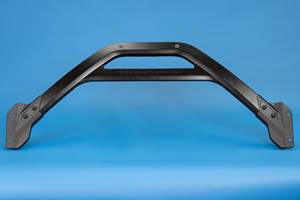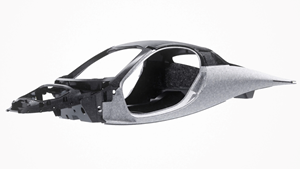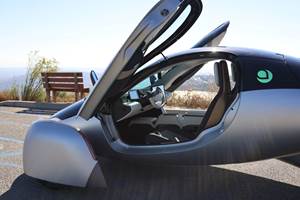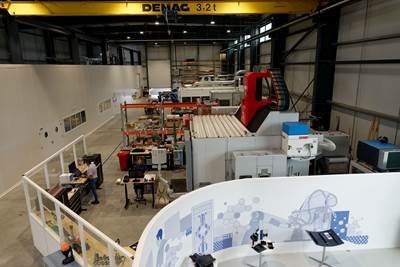The reality of carbon fiber for the auto industry today
Greg Rucks, a manager in the transportation practice at composites think tank Rocky Mountain Institute (RMI, Snowmass, Colo.), sees realistic pathways for carbon fiber incursion in to the automotive passenger car market.
Carbon fiber composites are too expensive for high-volume automotive production. The manufacturing processes can’t yet meet stringent automotive requirements for repeatability and production speed. The myriad combinations of fiber grades, forms, tow sizes and resin types creates an overwhelming number of options that are, to date, inadequately understood and characterized.
I’ve heard these arguments too many times to count. Although there is some truth to each, I contend that with careful planning and application selection, the auto industry is ready for cost-effective, high-volume production … right now, at 100,000 units per year. I’ll take each objection by turns, and explain why.
Manufacturing process maturity. At the U.S. Department of Energy’s (DoE) Fiber-Reinforced Polymer Composite Manufacturing Workshop (Jan. 13, 2014, in Arlington, Va.), participants from the transportation, energy and industrial sectors identified five composites manufacturing processes that are at the highest possible technology readiness level (TRL) short of commercialization. Several manufacturers are approaching one-minute cycle times, using both thermosets (e.g., fast-cure resins and very-high-pressure resin infusion) and thermoplastics (e.g., long-fiber thermoplastic injection molding, overmolding, thermoforming or compression molding). At 100,000 units per year, generally considered the high-volume threshold, a five-minute cycle time will suffice, and many processes can already hit that target.
Bottom Line: Process immaturity is not a show-stopping barrier.
Material complexity. Composites introduce a wider array of material options than do metals — their dual-material nature alone doubles the options. One must also select and combine compatible fiber forms, grades, surface treatments and tow sizes. In the auto industry, only fast-forming resins and processes will cut it, so automakers face fewer options. Having some options can be a good problem to have, so long as those options are clearly understood from a materials science standpoint. Further, material suppliers that are advancing automotive-capable material systems have made a greater effort than in the past to understand how parts will be manufactured. You won’t find material suppliers anywhere else, today, with such an intimate knowledge of material interactions and downstream part manufacturing.
Bottom Line: Composite material complexities pose some challenges for OEMs, but growing composites expertise among universities, government, and increasingly able suppliers can assist automakers in the selection of the best material options.
Material cost (vs. value). Often the automaker’s first objection, material cost drives part cost more than any other manufacturing consideration. But finding the right material option and understanding the way it and the processes fit together is a key to identifying cost-effective solutions in the near term. By most accounts, equipment, tooling and nonmaterial variable manufacturing costs are lower with composites than with steel. No, they’re not yet low enough to offset fiber cost, but our national labs and several carbon fiber manufacturers are hard at work trying to perfect lower-cost precursors.
That said, material cost is too often cited without regard to the value the material can bring to the end product. If customers are willing to pay for the value derived from carbon composites, or these materials enable cost reductions in enough other places in the auto production process, that can offset the upfront material cost premium and provide a feasible business case.
Car owners will pay for improved safety, for example, and composites offer some unique capabilities here. The challenge is quantifying the safety benefit via test methods and predictive computer-aided engineering tools. For the automaker, value includes part consolidation: reducing a subassembly from 50 to 20 parts has a big impact on assembly time and overhead and, therefore, part cost.
Bottom Line: Material cost is a real barrier, but it can be mitigated by value derived from a good application, design, material and process mix.
Supply chain fragmentation. Navigating material options is difficult because each company in a supply chain is typically focused on a highly specialized set of options and capabilities. To stay afloat in this volatile industry, automotive composites companies often had to pick a handful of material technologies (in the case of material suppliers) or manufacturing technologies (in the case of Tier 1s, equipment providers and toolmakers) and perfect them.
To ensure a company’s viability in an uncertain marketplace, that choice is motivated, in part, by the need to ensure that their specialties also apply in aerospace, marine, wind energy and other sectors. That’s why we don’t find much vertical integration in the carbon composites supply chain, and when we do, it likely isn’t optimized for auto applications. Few resin producers offer both thermosets and thermoplastics, for example, and tooling providers rarely have expertise in multiple manufacturing processes. As a result, carefully crafted, competitive supply chain partnerships are critical to kicking off successful automotive applications at scale.
But that gets to the heart of the real challenge: Supply chain candidates are typically specialists, not generalists, so some won’t fit with others, and when partnerships are forged, they can limit the technologies that are available for future (and unforeseeable) applications.
Yes, BMW has assembled a vertically integrated supply chain for its i-Series vehicles, but the composition of that supply chain is a case in point. Its capabilities are currently limited to a fairly specialized set of fiber forms and thermoset resin chemistry, and the high-pressure resin transfer molding process. Further, these choices had to be made years ago, during supply chain assembly. Debate continues: Were they the right choices? But one thing is certain. To take full advantage of carbon composites’ unique properties, BMW will (likely soon) need to diversify its process capabilities and expand its material options. That could require forays into new territory for existing suppliers or a whole new set of supply-chain partnerships.
Bottom Line: Assembling a compatible and capable supply chain is critical to commercialization at volume, but automakers must avoid inflexible arrangements that hinder future adaptability.
Transformed vehicles and the carbon fiber end game
So what will building carbon composite manufacturing capabilities mean for future vehicles? That requires a nuanced response, especially when it comes to electric vehicles. Carbon composites maximize vehicle lightweighting potential (and, therefore, operational energy efficiency), but the emissions benefit of mass reduction is largely negated by the energy-intensity of carbon fiber manufacture. More energy-efficient fiber production would mitigate this. Powering the processes with renewable energy would help, as BMW has done via hydroelectric power at its Moses Lake, Wash., fiber facility. So would the use of alternative precursors (e.g., polyolefin). Further, recycling carbon fiber would reduce its lifecycle emissions and slash fiber cost.
In the longer term, the role automobiles will play in an increasingly urban world must be considered. If transportation systems shift, for example, to shared, service-based models in which drivers pay only for miles traveled rather than purchasing or leasing vehicles that sit idle most of the time, then actual vehicle use could be increased dramatically. Further, increasingly reliable electrified powertrains and distinctively durable carbon fiber composite construction could substantially prolong a vehicle’s useful life. Increased utilization and extended life would mean a faster and bigger payback of the upfront investment in lightweight composite materials — and that would be true in terms of overall cost and emissions reductions.
Although many questions remain about the ultimate “end game” of automotive carbon fiber composites, their unparalleled potential for lightweight construction, durability, safety and simplified part production/assembly leave little question about their significant future role in vehicles.
The ultimate bottom line: There are winning pathways for carbon composites in high-volume auto production. Auto OEMs and their supply chains don’t necessarily need to know which future scenario will ultimately play out. The key is to get started now.
Related Content
Automotive chassis components lighten up with composites
Composite and hybrid components reduce mass, increase functionality on electric and conventional passenger vehicles.
Read MoreEnvalior offers novel Tepex composite for EV battery housings
Low-thickness, recyclable thermoplastic composite passes strict thermal runaway tests for EV battery housings.
Read MoreAptera joins forces with C.P.C. Group to accelerate solar EV production
Specialized composite bodies are being produced in Modena, Italy, for Aptera’s BinC vehicle, enabling eventual manufacturing ramp-up of 40 vehicles/day to meet demand targets.
Read MoreAptera reveals first composite production parts for BinC vehicle
Pre-production efforts are underway to begin building production-intent vehicles.
Read MoreRead Next
VIDEO: High-volume processing for fiberglass components
Cannon Ergos, a company specializing in high-ton presses and equipment for composites fabrication and plastics processing, displayed automotive and industrial components at CAMX 2024.
Read MorePlant tour: Daher Shap’in TechCenter and composites production plant, Saint-Aignan-de-Grandlieu, France
Co-located R&D and production advance OOA thermosets, thermoplastics, welding, recycling and digital technologies for faster processing and certification of lighter, more sustainable composites.
Read More“Structured air” TPS safeguards composite structures
Powered by an 85% air/15% pure polyimide aerogel, Blueshift’s novel material system protects structures during transient thermal events from -200°C to beyond 2400°C for rockets, battery boxes and more.
Read More

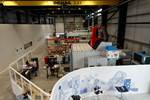


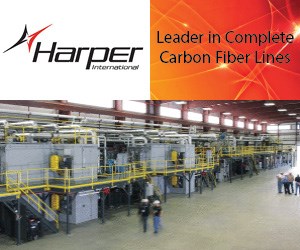



.jpg;maxWidth=300;quality=90)







